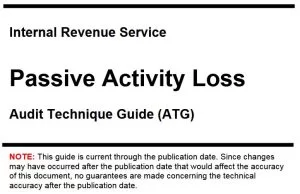
Business Advisory Services
Everything you need to help you launch your new business entity from business entity selection to multiple-entity business structures.
Hey - Our site just had a makeover and we are sorting through the hiccups!
Hey - Our site just had a makeover and we are sorting through the hiccups!

Everything you need to help you launch your new business entity from business entity selection to multiple-entity business structures.

Designed for rental property owners where WCG CPAs & Advisors supports you as your real estate CPA.

Everything you need from tax return preparation for your small business to your rental to your corporation is here.

WCG’s primary objective is to help you to feel comfortable about engaging with us
Table Of Contents


Common convention suggests that a loophole allows you to get around some inherent rule or limitation by finding an escape. According to some historians and BackThenHistory.com,
The word loophole dates to the mid-1500s. It comes from a combination of the word hole and the Middle English word loupe, which refers to the “narrow window” or “slit-opening in a wall” that archers used for protection while shooting. The figurative sense of the word loophole meaning “outlet” or “means of escape” didn’t come into usage until the 1660s.
Today, the word loophole is mostly used in legal applications, and to identify the inconsistency between parents when raising children where a child at the early age of 4 learns how to naturally manipulate. We digress.
The STR loophole can be summarized easily- if your rental property has an average guest-stay of 30 nights or fewer, then it is considered short-term and what the tax code also calls nonresidential. However, it is still considered a rental activity and as such is limited.
But if you average guest stay is 7 days or fewer, not only is it nonresidential it also considered not a rental activity but rather a trade or business. Next, if you materially participate in the short-term rental activity, the losses, especially during the early years or with a big fat cost segregation study, are deemed non-passive and therefore deductible beyond the passive loss limitations.
Sidebar: Having your rental property be considered nonresidential forces you to 39.0 years for depreciation but it also opens up the door for Section 179 expensing and opens more doors with qualified improvement property (QIP).
If you are a real estate professional, fitting the IRS definition, you mostly don’t care. Additionally, if you have other passive income (profit) that can absorb the passive losses from your rentals, you also don’t care. But if you own one rental or even a small gaggle of rentals that all experience rental losses, then the short-term rental tax loophole is your newest drinking buddy. Yes, everyone needs a drinking buddy, especially if they pick up the tab with a good tax deduction.
Let’s review this otherwise pain in our tax butt thing called passive loss limitations.

All this fun gibberish is from our rental property book, “I Just Got A Rental, What Do I Do?” and specifically Chapter 7 which is on the short-term rental loophole. Our book is available as an online Knowledge Base or you can grab the book version from Amazon.
In 1986, the Reagan administration passed a bunch of new tax code boringly called the Tax Reform Act (TRA), and one of the provisions severely limited the deduction of losses from passive activities where the taxpayer didn’t materially participate. The primary purpose of this tax code change was to stop certain tax behaviors that were deemed abusive. The change in tax code succeeded since tax-sheltered investment activity fell off a cliff shortly after.
Today, passive losses may still reduce other sources of income such as earned income (W-2) and portfolio / investment income, but it is capped. It is limited to $25,000 annually, which unfortunately hasn’t been indexed with inflation for multiple decades. This underscores the Treasury’s general opinion on passive losses. Next, this $25,000 is reduced $1 for every $2 over $100,000 in modified adjusted gross income (MAGI) for married filing jointly households. Simple math suggests that by $150,000 in MAGI, your passive losses are fully limited.
Passive losses that cannot be deducted in the current tax year are rolled forward and accumulated for later use, typically on Form 8582 Passive Activity Loss Limitations. Generally, these suspended losses, or what Form 8582 refers to as un-allowed losses, may be deducted against future passive income or if the activity (i.e., rental property) is sold.
There are two primary ways around the passive loss limitation; a) be considered a real estate professional as that term is defined by the IRS and not your bartender, or, b) leverage the short-term rental tax loophole.
Real estate professionals must spend the majority of their time in real property businesses which include development or redevelopment, construction or reconstruction, acquisition or conversion, rental, management or operation, leasing and / or brokerage.
Additionally, more than half of the personal services performed in all businesses and activities during the year must be performed in real estate activities. Read this again! If you have another full-time job selling used copiers in which you work 40 hours a week, you will need to work more than 40 hours per week in your real estate business. That can truly be a hard sell to the IRS. Said another way, that is 6 hours per day, 365 days a year, spent on your rentals (should you have a regular 40-hour a week job). Having W-2 income is listed in the IRS Audit Techniques Guides (ATG) for Passive Activity Losses as a trigger for a possible IRS challenge.
Sidebar: If your W-2 job is in real estate activities such as being an appraiser or if you own 5% of a real estate business (developer, construction, property management, etc.) then this time counts.

Meet the above, and poof, you are a real estate professional or what some call REPS for real estate professional status and your activity is no longer labeled passive and therefore is no longer limited to losses for tax deduction purposes.
One of the often-overlooked benefits of REPS is avoiding net investment income tax (NIIT) on rental profits and on gains from your rental property sale. This article mostly focuses on passive losses. However, we’d like to note: if you have rental activities that result in taxable income and your household income is $250,000 or more for those married filing jointly, your rental income might be deemed investment income and as such be subject to the 3.8% NIIT. See our Selling Your Rental Property KB article from our book.
As mentioned earlier, there are two ways to have passive activity losses reduce non-passive income. One is the real estate professional designation, and the other is the short-term rental loophole. Yeah, we’ve taken a minute to get to the meat of this article, but you’re better for it. For real!
The general gist of the STR loophole is quite simple. If the average stay of your guests over the course of the tax year (only considering actual rented days) is 7 days or fewer, and you materially participate in the activity (think business owner versus investor), then your short-term rental is no longer a rental activity, and in turn is no longer passive. To take this one step further, since your investment into the rental property is considered at-risk, losses from this type of activity are not limited. They may be deducted against other sources of income such as W-2, K-1 from an S Corp, investment income, etc. Yay!
The rental activity can be viewed as commercial, or at least having enough commercial substance to not be deemed passive. One of the consistencies with this STR loophole element is that short-term rentals must be depreciated over 39.0 years, as compared to 27.5 years. A lot of tax professionals mess this up since it is a bit obscure. However, if you look at a cost segregation report from a reputable firm, it should show 39.0 years for the remaining asset’s depreciation if the property is deployed as a short-term rental. We’ll go one step further- if your rental has an average guest stay of 30 days or fewer, it is considered nonresidential and must also be depreciated over 39.0 years.
Sidebar: Computing average guest stay can be harder than you think. What if you convert from long-term to short term? What if your bookings span over December 31- which tax year do you apply it to? Read our Computing Average Guest Stay KB article from our rental property book.
A situation may arise where the rental property was short-term for year 1 and 2, but converted to long-term in year 3. Depreciation calculations must be adjusted in year 3 to use 27.5 years and not 39.0 years. The same happens if you go the other way. A Form 3115 Application for Change in Accounting Method is required to be filed since the useful life of the asset has been determined by the tax code, and you are either moving to or moving from a codified useful life. It’s not a big deal, and it takes some time since it’s shockingly overly complicated for a simple depreciation change, but it’s required to be filed along with your 1040 tax return.

What we are about to say is not a recommendation, but an observation worthy of mentioning. You could easily rent your rental property for 7 days or less, deduct a bunch of expenses including your big fat cost segregation depreciation expense, and then later convert it to a long-term rental or even a 30-day vacation rental. At that moment in time, usually a tax year, if your rental activity is a short-term rental, and you later convert it, you do not have to amend or restate your prior tax returns. Each year stands on its own. Having said this, you better have your record keeping ducks lined up. Quack quack.
Many cities and various municipalities are cracking down on short-term rentals. Sure, people complain about the additional cars, noise, and shenanigans associated with the inherent turnover of guests at a rental property. The hotel industry seems to enjoy this turnover since it typically means higher rents (short rent periods = higher daily rates), but they don’t like competition. As such, they leverage busy body Betty, take her complaints to local governments and influence code changes.
Some kidding aside, the other reason for these ordinance changes is a deemed housing shortage. Some governments believe that a bunch of typical homes are being pulled off the market as a residence and re-deployed as a short-term rental (a long-term rental can be viewed as a net-zero or neutral within this argument). However, in glamorous cities such a New York City and San Francisco, short-term rentals help long-term renters with high rent costs by augmenting their household income with sporadic rental income.
Moving on…
WCG CPAs & Advisors encourages short-term rentals to be owned by partnerships (ie, a multi-member LLC). Why? For three reasons:
First, the historical audit rate of partnerships (Form 1065) is 0.4%. Super low compared to individual tax returns (Form 1040) which might be 4% to 12% depending on your income levels. Why does this matter?
When you have a big cost segregation plus significant startup expenses like furniture and supplies, it results in a large tax deduction against your substantial W-2 income. This happens because your passive losses are no longer limited due to your significant material participation. Large tax deductions raises eyebrows. Cute, electronic AI eyebrows, but eyebrows nonetheless.
Second, with a partnership tax return, we can mechanically show your capital contribution (at-risk money) including recourse loan debt. Why does this matter? Let’s say you invest $250,000 into a new business, and that business loses money. The IRS sees your “partner basis,” the $250,000, within your 1040 tax return, and suddenly the $100,000 first-year loss doesn’t seem so out-of-whack. A short-term rental is certainly a business activity; sure, you might not have a profit right away, but you will make money someday (otherwise you wouldn’t do it, right?).
Third, all rental activities, including STR activities, within a partnership tax return are reported on Form 8825. This is another layer of cloaking within the 1065 tax return, and allows your rental income and deductions to fly just a little closer to the ground as compared to Schedule E page 1 of your 1040 tax return. There are three degrees of separation: the 1040 to the K-1 to the 1065 to the 8825, all wrapped with a nice basis information. Wow, we really geeked out there.
Other minor benefits include anonymity of the enterprise, orderly transfer of ownership within the LLC’s Operating Agreement (versus a trust or will), discounted gifting of interests to others such as your kids, and some enhanced protection with charging orders (super flimsy, but they still exist).
Downsides are the additional tax return preparation fees. Please review our business entity tax return webpage for more information. Another downside might be additional state taxes such as California’s franchise tax and LLC fee, which can be summarized as money-grabs or pleasure to do business in our state fees. Section 179 is limited at the entity level, and can be problematic. You need to consider your exposure versus the cost of reducing your exposure and therefore subsequent risk. Read our Downsides to Rental in Partnerships KB article from our rental property book.
How do you create a partnership? If you are married, this is quite simple… you and your spouse would be members of a multi-member LLC. Not married? There are other options. You could have a sibling, parent, or child hold economic interests in the entity (LLC, for example). They would not hold equity interests, but the arrangement would be considered a partnership, and reported on a partnership tax return. Of course, this second method might be more hassle than it is worth, but the first example… the spousal version… is easy. Don’t run off and get married just to make a partnership. That’s nutty.
We can easily help with the multi-member LLC formation.
This is a reprint from our Real Estate Professional article but with slight changes suited towards the short-term rental tax loophole. For a complete discussion short-term rental material participation including what time counts and time tracking, please see our STR Loophole chapter from our rental property book. Good stuff!
Moving on… There are several requirements for material participation, and satisfaction of any one test will allow you to be considered materially participating. We’ll discuss each one in turn, and refer to notes from the IRS Audit Techniques Guide (ATG) for each test, including case law when applicable.
1. You participated in the activity for more than 500 hours.
ATG Notes: If the taxpayer participates more than 500 hours during the year in a business, income, or loss from the activity will be non-passive. Participation of both spouses is counted, but not participation of the children or employees. Participation in operations must be regular, continuous, and substantial. The examiner should determine whether the quantity of time documented is reasonable in light of other obligations.
What exactly does “regular, continuous, and substantial” mean? No definition is provided in the Internal Revenue Code or other regulations. However among Technical Advice Memorandums (TAMs) and Tax Court Cases, a general notion exists that for a taxpayer to materially participate, the taxpayer must be involved in the day-to-day management and operations of the rental activity (similar to a trade or business).
Examination Techniques: Review W-2s and other non-passive activities. Does it seem likely that the taxpayer claiming to materially participate could spend 500 hours on the activity in light of other employment obligations? Ask questions on taxpayer material participation activity time early in the examination. Establish time the taxpayer spends on all activities during the initial interview if possible. Determine the location of each activity. If located far from the taxpayer’s residence, how likely is the taxpayer to have spent substantial time on the activity?
Tax Court: Despite the IRS’s ATG notes on passive activities, the Tax Court in Pohoksi v. Commissioner, Tax Court Memo 1998-17 implied that they would entertain proof that the taxpayer substantially participated as compared to the participation of a property management company. This is a satisfaction of test #2.

ATG Notes: Stated simply, if the taxpayer does most of the work, income, or loss will be non-passive. The involvement in the activity of an employee or non-owner could cause the taxpayer to fail this test. There is no specific number of hours associated with this test. In addition, the term “substantially” is not defined in the regulations.
Tax Court: In Pohoski, the Tax Court noted that the taxpayer did not introduce evidence of the hours spent by a property management company. The Tax Court implied that they would entertain proof that the taxpayer substantially participated as compared to the participation of a third party (in this case a property management company). Pohoski v. Commissioner, Tax Court Memo 1998-17 stated the second test was not satisfied when taxpayers failed “to put forth some indication of the actual time spent by” third-party non-owners in activities on the property.
This is brutal- so a word to the wise, you should attempt to maintain the work hours spent by others in addition to your own. The additional record keeping and possible corroboration can be a back-breaker for underpinning participation for the short-term rental tax loophole.
3. You participated in the activity for more than 100 hours during the tax year, and you participated at least as much as any other individual (including individuals who did not own any interest in the activity) for the year.
ATG Notes: If a taxpayer participates in an activity for more than 100 hours and no other individual participates more than the taxpayer (including any employee or non-owner), income or losses from the activity are non-passive.
Examination Techniques: Be alert to employees who are managing the activity, indicating the taxpayer deducting the losses may not be materially participating (particularly on Form 1040 Schedules C and F). When reviewing taxpayer hours, watch for “investor” activities (Internal Revenue Code Section 1.469-5T(f)(2)(ii)). The taxpayer must be involved in the activity’s day-to-day management or operations. Hours spent toward reviewing financial statements, preparing analysis for personal use, and monitoring the activity in a non- managerial capacity do not count. Heavy emphasis on non-managerial, this is the hinge between investor and material participant.
4. The activity is a significant participation activity (SPA), and you participated in all significant participation activities for more than 500 hours.
A significant participation activity is any trade or business activity in which you participated for more than 100 hours during the year and in which you did not materially participate under any of the material participation tests, other than this test.
ATG Notes: The term significant participation activity is unique to Internal Revenue Code 1.469-5T. If the sum of the taxpayer’s time in all SPAs is more than 500 hours for the year, then income or losses from the businesses are non-passive and the taxpayer might be considered a real estate professional. For each SPA, the regulations require: The taxpayer to participate more than 100 hours during the year. The activity must be a business, i.e., it cannot be a rental or investment activity. The business must be a passive activity. Thus, if the taxpayer works more than 500 hours in the business, it is not a SPA as 500 hours is one of the qualifying tests for material participation. Similarly, if the taxpayer does most of the work in the business, it cannot be a SPA as Internal Revenue Code Section 1.469-5T(a)(2) holds that performing substantially all the work qualifies for material participation.
5. You materially participated in the activity for any 5 (whether or not consecutive) of the 10 immediately preceding tax years.
ATG Notes: An activity is non-passive if the taxpayer had been treated as materially participating in any 5 of the previous 10 years (whether or not consecutive). This test usually applies when a taxpayer “retires from material participation” but maintains an ownership interest in the activity.
Examination Techniques: Even if the taxpayer performs no services for a business currently, the examiner should inquire about involvement in prior years and review the returns to see if income or losses were treated as non-passive.
6. The activity is a personal service activity in which you materially participated for any 3 (whether or not consecutive) preceding tax years.
An activity is a personal service activity if it involves the performance of personal services in the fields of health, including veterinary services. This applies to: law, engineering, architecture, accounting, actuarial science, performing arts, consulting, or any other trade or business in which capital is not a material income-producing factor.
ATG Notes: None.
Examination Techniques: None.
Tax Court: As far as we can tell, this test has not been used in tax court involving short-term rentals or real estate professionals.
Some real estate investors and tax strategists have argued that operating rental properties is a personal service. We disagree. The personal services listed in this test are traditional service professions where you would have clients or patients. Of course, an argument could be made that tenants are clients, but the one hiccup is the rental property itself. The personal service would not exist if it wasn’t for the building, therefore capital is a material income-producing factor (income comes from rents, rents come from tenants, tenants live in buildings, buildings require capital for acquisition).
Said in another way, the personal service is being spent on the building (maintenance, approving who gets to use it, recording transactions regarding the building, etc.) rather than on a person. Therefore, it is not truly personal service. Personal service has the word person in it to boot! Also, doesn’t #6 look eerily similar to the rules in Section 199A qualified business income deduction.
7. Based on all the facts and circumstances, you participated in the activity on a regular, continuous, and substantial basis during the year.
ATG Notes: The facts and circumstances test may apply if none of the other tests are met. This test does not apply unless the taxpayer worked more than 100 hours a year. Furthermore, the taxpayer’s time spent managing will not count if: Any person received compensation for managing the activity and any person spent more hours than the taxpayer managing the activity.
Examination Techniques: Taxpayers may argue the facts and circumstances test when they fail the others. However, due to the stringent limitations, few taxpayers can meet the facts and circumstances standard. If there is paid on-site management, the facts and circumstances test cannot be used.
Summary
See Doing Time and specifically the section on Acquisition Time below for a discussion on the underpinnings of material participation.
Also, if you owned an activity as a limited partner or member, you generally are not treated as materially participating in the activity. However, you are treated as materially participating in the activity if you met test #1, #5 or #6 described above. You can also see Tax Court Summary 2012-91 (Chambers) for some real snoozer material.
Finally, the three most common material participation tests for short-term rental loophole are-
In the previous section, there were little tidbits from the Audit Techniques Guide (ATG) about what to look for as an IRS auditor. We will pull these down and summarize here again, plus some additional information.
IRS Publication 925 has this blurb when referencing active participation- Management decisions that count as active participation include approving new tenants, deciding on rental terms, approving expenditures, and similar decisions.
It continues to talk about work that is not normally done by owners and investor activities (versus managerial activities). Here is another blurb from the IRS Pub-
Work not usually performed by owners. You don’t treat the work you do in connection with an activity as participation in the activity if both of the following are true.
1. The work isn’t work that’s customarily done by the owner of that type of activity.
2. One of your main reasons for doing the work is to avoid the disallowance of any loss or credit from the activity under the passive activity rules.Participation as an investor. You don’t treat the work you do in your capacity as an investor in an activity as participation unless you’re directly involved in the day-to-day management or operations of the activity. Work you do as an investor includes:
1. Studying and reviewing financial statements or reports on operations of the activity,
2. Preparing or compiling summaries or analyses of the finances or operations of the activity for your own use, and
3. Monitoring the finances or operations of the activity in a non-managerial capacity.
Therefore, talking to your wonderful short-term rental experts at WCG CPAs & Advisors about tax returns might not count. However, if we chat about contracts, problems with renters, reviewing tenant agreements, then yes! We are not just tax professionals, we are also landlords too.

We also exclude the time Mr. Lucero spent driving between the Sea Ranch property and his Sacramento home. We recognize that petitioners drove several hours each way, but they “bear the expense of commuting (driving time) because it is a personal expense unless an allocation for additional expenses can be made between personal and business expenses.”
Additionally, Mr. Lucero’s log reported hours for tasks that appear excessive in relation to the task described, such as spending two hours shopping for coffee filters at Bed Bath & Beyond, and included time shopping both for the Sea Ranch property and for personal items, such as one hour shopping at Gualala Supermarket for 2 items for the Sea Ranch property (garbage bags and facial tissue) and more than 20 personal grocery items. We have found the credibility of a taxpayer’s records to be diminished when the number of hours reported appears excessive in relation to the task described.
In Pohoski, the Tax Court noted that the taxpayer did not introduce evidence of the hours spent by a property management company or its individual employees. The Tax Court implied that they would entertain proof that the taxpayer substantially participated as compared to the participation of a third party (in this case a property management company). Pohoski v. Commissioner, Tax Court Memo 1998-17 stated the second test was not satisfied when taxpayers failed “to put forth some indication of the actual time spent by” third-party non-owners in activities on the property.
Time spent acquiring the rental property might count but only qualifying for the 750 hours test as a real estate professional (as defined by the IRS). Time spent searching for a rental property, inspecting the property and other associated acquisition time does not count for material participation. Before you blow up, we do offer an out for short-term rentals but let’s work through the madness first.
Let’s review IRC Section 469(c)(7)(C) of the IRS code again for fun-
For purposes of this paragraph, the term “real property trade or business” means any real property development, redevelopment, construction, reconstruction, acquisition, conversion, rental, operation, management, leasing, or brokerage trade or business.
However, it is important to understand the overall umbrella of IRC Section 469. It is titled, “Passive activity losses and credits limited.” It is not about material participation per se. Having said that, IRC Section 469 does discuss material participation to determine if an activity is passive or non-passive. Specifically, IRC Section 469(h) reads-
(h) Material participation defined
For purposes of this section-
(1) In general a taxpayer shall be treated as materially participating in an activity only if the taxpayer is involved in the operations of the activity on a basis which is-
(A) regular,
(B) continuous, and
(C) substantial.
What are we getting at here? It is easy to throw all this into a material participation passive activity loss real estate professional status stew and think that the word “acquisition” is somehow connected to material participation. It is not.
More importantly, Treasury Regulations Section 1.469-5T starts with-
(a) In general. Except as provided in paragraphs (e) and (h)(2) of this section, an individual shall be treated, for purposes of section 469 and the regulations thereunder, as materially participating in an activity for the taxable year…
From there the regulations list out the seven various tests.
Therefore, and at the risk of stating the obvious, you need an activity to materially participate in. This begs the question- if you wake up and decide to start a business, an activity is now launched and you can start counting your hours. Why can’t you do the same for rental properties?
We must determine when a rental activity starts especially as it relates to material participation. More rules!
Treasury Regulations Section 1.469-1T(e)(3) read-
(3) Rental activity
(i) In general. Except as otherwise provided in this paragraph (e)(3), an activity is a rental activity for a taxable year if—
(A) During such taxable year, tangible property held in connection with the activity is used by customers or held for use by customers; and
(B) The gross income attributable to the conduct of the activity during such taxable year represents (or, in the case of an activity in which property is held for use by customers, the expected gross income from the conduct of the activity will represent) amounts paid or to be paid principally for the use of such tangible property (without regard to whether the use of the property by customers is pursuant to a lease or pursuant to a service contract or other arrangement that is not denominated a lease).
Did you read each word? Ah, you’re better for it if you did. What all this nonsense is saying is that you must have a rental property “used by customers or held for use by customer” for your activity to be a rental activity. In other words, you need an asset, the rental property, to be placed in service. Treasury Regulations Section 1.167(a)-11(e)(1)(i) define “placed in service,” and can be summarized as ready and available for occupancy, and held out for rental use through advertising and related efforts.
But there is another wrinkle to all this. Short-term rentals with average guest stay of 7 days or less are not considered rental activities. Huh? Why does this matter?
Let’s go to the regulations! Treasury Regulations Section 1.469-4, titled “Definition of an activity,” reads in part-
(b) Definitions. The following definitions apply for purposes of this section—
(1) Trade or business activities. Trade or business activities are activities, other than rental activities or activities that are treated under § 1.469-1T(e)(3)(vi)(B) as incidental to an activity of holding property for investment, that—
(i) Involve the conduct of a trade or business (within the meaning of section 162);
(ii) Are conducted in anticipation of the commencement of a trade or business; or
(iii) Involve research or experimental expenditures that are deductible under section 174 (or would be deductible if the taxpayer adopted the method described in section 174(a)).
What does this mean? You are considered to have an activity by the mere anticipation of the commencement of a trade or business that is not a rental activity. Therefore, since a short-term rental is not considered a rental activity, you nonetheless have an activity that you can materially participate in without necessarily having the asset (e.g., the rental property) placed in service.
Let’s stop for a moment and consider selling used copiers as your new business. The moment you wake up and start procuring inventory, negotiating contracts, creating marketing materials, hiring a staff or support team of contractors, buying office furniture and equipment, deploying an accounting system, among the myriad of other things business owners do, you are materially participating in your used copier activity.
Why is procuring a short-term rental, signing up with Airbnb or a management company, launching a website or rental listing, shopping for linens and supplies, etc. be any different than your used copier business? It isn’t, right?
Sure, one could argue that your time spent in the examples above might not be regular, continuous, and substantial as required by IRC Section 469(h). Then again, these are squishy terms and open for wide interpretations.
Who could use a summary right about now?
Here’s the caveat- as explained throughout this book, time spent on short-term rental properties does not count towards your 750 hours for real estate professional status because… and you might have guessed it… STRs are not rental activities nor are they considered real estate activities. Rather, they are like hotels. Operating a hotel does not count towards REPS either.
So, we’ve carved out this little nugget for short-term rentals but we must be mindful of investor time. The following items likely would not count for material participation even with short-term rentals-
There are others of course, and there are likely ones that are gray. Ah, the beauty of our tax code!
What about buying a rental on December 1 and placing it immediately into service as a short-term rental, pick up a couple of reservations, and take a nice tax deduction? Not so fast. In Gregg v. U.S. 186 F.Supp.2d 1123, the court stated:
Defendant argues, however, that neither Section 469 nor the regulations promulgated thereunder provide for such proration in the event of a short year. The defendant states that the plain language “if and only if” contained in § 1.469-5T(a), denotes a requirement of strict compliance. In addition, if proration is allowed, 500 hours per year equates to less than 10 hours per week. Such a deminimis standard of “material participation” acts against the Secretary of the Treasury’s strong interest in preventing taxpayers from initiating or acquiring passive activities at the close of a taxable year, and then characterizing those losses as non-passive, and deducting the losses against ordinary income. Although, as plaintiffs argue, no regulation or case law prohibits annualizing the participation hours in the event of a short year, I defer to the defendant’s explanation on how the first test should be applied.
I appreciate plaintiff’s frustration regarding the application of this test, since timing of the formation of a business entity ironically affects the determination of the nature or level of a taxpayer’s participation in the business activity under the first test. However, plaintiff chose to form Cadaja as an LLC over other organizational forms in November of tax year 1994 for various business reasons, which may or may not include tax considerations. Application of this test without strict compliance will open the floodgates defeating the regulations’ purposes. Therefore, I find that plaintiff fails to meet the 500-hour-per-year threshold requirement under the first test.
Here is a zinger- since a short-term rental with an average guest stay of 7 days or less with your material participation is not considered a rental activity, it is also not considered a real estate activity. It is more like a hotel. As such, and you can start groaning now, your time spent on your STR does not count towards your 750 hours needed for real estate professional status (REPS). Wait, what? It’s true! Temporary Treasury Regulations 1.469-1T(e)(3) reads “an activity involving the use of tangible property is not a rental activity for a taxable year if for such taxable year the average period of customer use for such property is seven days or less.” You can read more in our What Hours Can You Count For REPS KB article from our rental book.
There you go. All kinds of maddening time issues to navigate. To summarize, the big 3 material participation portals for rentals in general and the short-term rental loophole are-
We recommend not stopping at 500 or 100 hours with your material participation time log. Every minute counts, and every minute beyond 500 or 100 hours is just good insurance.
Also! Do not confuse the active or material participation rules above with the 750 hours required for Real Estate Professionals. The 750 hour rule is way more liberal, and also keep in mind that to have REP status means 750 hours plus material participation- participation hours will usually be a subset of the 750, but not all hours in the 750 will be considered participation in the activity. Subtle difference.
You are purchasing real estate property for business or rental use. Typically, the entire purchase price less the portion attributable to land is depreciated over 27.5 or 39.0 years. This can really drag on forever, and not just forever, but forever and ever. For example, a $400,000 single-family rental property with $100,000 attributed to land will have about $10,909 annually in depreciation which is 3.64% of $300,000.
At a mid-range marginal tax rate of 24%, this puts $2,618 into your pocket. Not shabby. But what if you could depreciate in big chunks? Accelerate depreciation through bonus depreciation and / or Section 179 expensing? What about $50,000 in one year (which is a good starting point using our example above). Now you get to put $12,000 extra in your pocket during the first year. Accelerated cash flow is always nice. Yay!
But given what we know about passive losses, and the likely limitation based on the household income needed to be in the 24% marginal tax bracket, accelerated depreciation is useless. However, if you combine short-term rental loophole with cost segregation, or costseg as the cool kids say, then you win regardless of modified adjusted gross income.
How does all this black magic work?

Learn about cost segregation techniques and rental property depreciation for tax benefits.
It’s a way to treat your rental like a business instead of a passive investment. If your average stay is 7 days or fewer and you materially participate, your losses can offset W-2, K-1, or investment income—no passive loss limits in sight.
An average guest stay of 30 days or fewer is technically short-term, or nonresidential, but 7 days or fewer is where the loophole magic happens and your property becomes a non-rental trade or business for passive activity loss purposes.
STRs are considered nonresidential property, which means a 39-year depreciation schedule. The upside? Access to Section 179 and bonus depreciation—bigger front-loaded tax deductions.
Nope. Common misconception. STR rules stand alone. While REPS is another way to unlock non-passive treatment, it does not need to be paired with short-term rentals (and often you want to keep these worlds separate).
Regular rentals are capped at a $25,000 annual loss allowance that phases out by $150,000 in modified adjusted gross income (MAGI). Qualifying STRs bypass those limits entirely. Yay!
Another common head-scratcher. Usually Schedule E. But if you start offering hotel-like services (daily cleaning, concierge, tours), it shifts to Schedule C—and brings self-employment tax along for the ride should you have a profit.
Time logs are your best friend. Show you worked 500 hours, 100 hours and more than anyone else, or did substantially all the work yourself. Record the date, time, place and what you did with annoying specificity.
Yes, but you’ll need to adjust depreciation and sometimes file Form 3115. Conversions don’t require amending past returns and they also don’t taint or change future tax years. You could conceivably go back and forth several times over the years of ownership. You real estate CPA might go mad, but that’s their problem.
It’s the ultimate power combo—pairing cost segregation with the short-term rental loophole accelerates depreciation and turns large first-year paper losses into real tax savings.
Partnerships often face lower audit risk, clearly show your at-risk basis, and keep your STR numbers discreetly tucked inside a tax return separate from your 1040 tax return. It’s tidy, efficient, and smart risk mitigation.

Want to talk to us about tax return preparation, tax planning and strategy, and all the other things that go with it? We are eager to assist! The button below takes you to our Getting Started webpage, but if you want to talk first, please give us a call at 719-387-9800 or schedule an discovery meeting.
Jason Watson, CPA is a Partner and the CEO of WCG CPAs & Advisors, a boutique consultation and tax preparation CPA firm serving clients nationwide with 7 partners and over 90 tax and accounting professionals specializing in small business owners and real estate investors located in Colorado Springs.
He is the author of Taxpayer’s Comprehensive Guide on LLC’s and S Corps and I Just Got a Rental, What Do I Do? which are available online and from mostly average retailers.
Table Of Contents

Tax planning season is here! Let's schedule a time to review tax reduction strategies and generate a mock tax return.

Tired of maintaining your own books? Seems like a chore to offload?
Did you want to chat about the short-term rental loophole and how it can be leveraged? Do you have questions about how it all works? Are you curious about STR loophole pitfalls and problems? Let's chat!
The tax advisors, business consultants and rental property experts at WCG CPAs & Advisors are not salespeople; we are not putting lipstick on a pig expecting you to love it. Our job remains being professionally detached, giving you information and letting you decide within our ethical guidelines and your risk profiles.
We see far too many crazy schemes and half-baked ideas from attorneys and wealth managers. In some cases, they are good ideas. In most cases, all the entities, layering and mixed ownership is only the illusion of precision. As Chris Rock says, just because you can drive your car with your feet doesn’t make it a good idea. In other words, let’s not automatically convert “you can” into “you must.”
Let’s chat so you can be smart about it.
We typically schedule a 20-minute complimentary quick chat with one of our Partners or our amazing Senior Tax Professionals to determine if we are a good fit for each other, and how an engagement with our team looks. Tax returns only? Business advisory? Tax strategy and planning? Rental property support?

Everything you need to help you launch your new business entity from business entity selection to multiple-entity business structures.

Designed for rental property owners where WCG CPAs & Advisors supports you as your real estate CPA.

Everything you need from tax return preparation for your small business to your rental to your corporation is here.

WCG’s primary objective is to help you to feel comfortable about engaging with us

